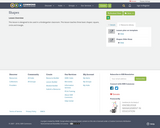
In this scavenger hunt game students practice copying shapes.
- Subject:
- Geometry
- Mathematics
- Material Type:
- Activity/Lab
- Provider:
- Illustrative Mathematics
- Provider Set:
- Illustrative Mathematics
- Author:
- Illustrative Mathematics
- Date Added:
- 07/20/2012

In this scavenger hunt game students practice copying shapes.

In this scavenger hunt games students are given the task of finding and identifying real-world shapes in their environment.

In this "word search" style puzzle students practice identifying sequences of shapes.

This activity incorporates balance and movement along with many different mathematical concepts.

This is a lesson to teach children in pre-kindergarten to recognize and differentiate between shapes. It includes videos, games, and activities that can be done as a group or independently.

This lesson is designed to be used in a Kindergarten classroom. This lesson teaches three basic shapes: square, circle and triangle.

Practicing geometry and writing skills, students will use two-dimensional shapes to build a house on a page, then write a sentence using sight words and encodable words such as "I have a little house." They can be required to identify each shape as they remove it from their "house." This is beneficial in making connections across curriculum between language arts and math skills. It give hands-on practice with identifying shapes by their characteristics, as well as use of sight words and encoding words (or copying from what teacher provides if desired.)

Students will identify and compare attributes of two-dimensional and three- dimensional shapes in the world around them.

Students are introduced to brainstorming and the design process in problem solving as it relates to engineering. They perform an activity to develop and understand problem solving with an emphasis on learning from history. Using only paper, straws, tape and paper clips, they create structures that can support the weight of at least one textbook. In their first attempts to build the structures, they build whatever comes to mind. For the second trial, they examine examples of successful buildings from history and try again.

Exploratory play is about asking questions: “What happens when I do this?” “What if I did it this way?” Experimenting with materials and pushing their limits encourages us to consider a wide range of possibilities when problem-solving. Playing around with objects and ideas helps us see that there may be more than one solution.

Students learn about the fundamental strength of different shapes, illustrating why structural engineers continue to use the triangle as the structural shape of choice. Examples from everyday life are introduced to show how this shape is consistently used for structural strength. Along with its associated activity, this lesson empowers students to explore the strength of trusses made with different triangular elements to evaluate the various structural properties.

Students learn about ultrasound and how it can be used to determine the shapes and contours of unseen objects. Using a one-dimensional ultrasound imaging device (either prepared by the teacher or put together by the students) that incorporates a LEGO(TM) MINDSTORMS(TM) NXT intelligent brick and ultrasonic sensor, they measure and plot the shape of an unknown object covered by a box. Looking at the plotted data, they make inferences about the shape of the object and guess what it is. Students also learn how engineers use high-frequency waves in the design of medical imaging devices, the analysis of materials and oceanographic exploration. Pre/post quizzes, a worksheet and a LEGO rbt program are provided.

This is an inquiry-based lesson plan about shapes for standard K. RV. 2.2: Identify and sort pictures of objects into categories (e.g., colors, shapes, opposites).